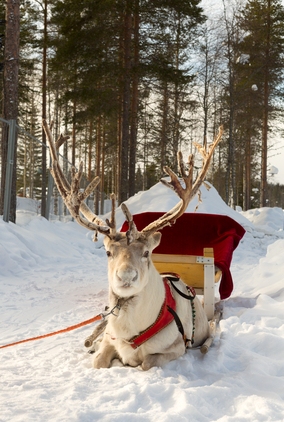Christmas Traditions »
 The character of Santa Claus is largely based on St. Nicholas of Myra and Sinterklaas of Dutch lore. Both of those figures traveled via a noble, white steed. Yet in some Western cultures, particularly America, Santa Claus travels the world on Christmas Eve delivering gifts in a sleigh pulled by flying reindeer.
The character of Santa Claus is largely based on St. Nicholas of Myra and Sinterklaas of Dutch lore. Both of those figures traveled via a noble, white steed. Yet in some Western cultures, particularly America, Santa Claus travels the world on Christmas Eve delivering gifts in a sleigh pulled by flying reindeer.
In 1812, American author Washington Irving refers to St. Nicholas as “— riding over the tops of the trees, in that self-same wagon wherein he brings his yearly presents to children” in the revised version of A Complete History of New York written under the pseudonym Diedrich Knickerbocker. Yet no mention is made of what propels the wagon. So where did the story of flying reindeer originate?
The first known written account of reindeer in association with the legend of Santa Claus occurred in 1821. That year, New York printer William Gilley published a sixteen page booklet titled A New Year’s Present, to the Little Ones from Five to Twelve Number III : The Children’s Friend by an anonymous author. In the book, reindeer are introduced into the Santa Claus narrative:
Old Santeclaus with much delight
His reindeer drives this frosty night.
O’er chimneytops, and tracks of snow,
To bring his yearly gifts to you.
During an 1822 interview, New York’s Troy Sentinel editor Orville L. Holley questioned Mr. Gilley regarding the booklet’s author and the topic of reindeer. Though he did not identify the author, Mr. Gilley responded:
“Dear Sir, the idea of Santeclaus was not mine nor was the idea of a reindeer. The author of the tale but submitted the piece, with little added information. However, it should be noted that he did mention the reindeer in a subsequent correspondence. He stated that far in the north near the Arctic lands a series of animals exist, these hooven and antlered animals resemble the reindeer and are feared and honored by those around, as you see he claims to have heard they could fly from his mother. His mother being an Indian of the area.”
In 1823, the Troy Sentinel published the poem A Visit From St. Nicholas, commonly known as The Night Before Christmas. The poem features eight flying reindeer pulling Santa’s sleigh and, for the first time, they are identified by name:
When what to my wondering eyes should appear,
But a miniature sleigh and eight tiny reindeer,
With a little old driver, so lively and quick
I knew in a moment it must be St. Nick.
More rapid than eagles his coursers they came,
And he whistled and shouted and called them by name;
“Now, Dasher! now, Dancer! now, Prancer and Vixen!
On, Comet! on, Cupid! on, Dunder and Blixem!
To the top of the porch, to the top of the wall!
Now, dash away, dash away, dash away all!”
Though originally called ‘Dunder and Blixem’ in the 1823 publication, Santa’s seventh and eighth reindeer are commonly known as ‘Donner and Blitzen’ today. Dunder and Blixem are Dutch words that translate to thunder and lightning. Some 19th and 20th century publications of the poem substituted the names ‘Donder and Blitzen’, which are German for thunder and lightning, and in other articles during the 20th century, ‘Donner’ replaced the name ‘Donder’. After Johnny Marks penned the song Rudolph The Red-Nosed Reindeer in 1949, based on the story by Robert L. May, the name ‘Donner’ became the most popular spelling for the seventh reindeer originally named ‘Dunder’ in the poem A Visit From St. Nicholas. May’s story and Marks’ song were both well received and Rudolph is without doubt the most famous addition to Santa’s team.
The above information helps determine the first written accounts of reindeer in conjunction with Santa, but how did reindeer come to be associated with Santa Claus in the first place? Many popular Christmas traditions related to Santa Claus were brought to America by Dutch and German immigrants. As the persona of Santa Claus and celebration of Christmas were being developed in the west, customs and myths from foreign lands, including those of Scandinavian and European countries, were incorporated.
As pagans converted to Christianity during the Middle Ages, winter festivals and traditions, as well as popular pagan beliefs, often mingled with Christian celebrations of Christmas. In Norse and Germanic mythology, Thor is the God of Thunder and soars through the sky in a chariot pulled by two magical goats. Thor was highly revered and was arguably the most popular of Norse gods in ancient times. Images and stories of Thor soaring the skies in his sleigh pulled by two large, horned goats may have influenced the creation of Santa’s sleigh and flying, antlered reindeer by those in the west familiar with Dutch or Germanic mythology.
Reindeer were once viewed as mysterious creatures linked to lands in the northern part of the world. Their population was widespread in Scandinavian and Eastern European countries where, during the 18th century, they were domesticated. They were often used in transportation, pulling sleds and sleighs, and are still an important aspect of some indigenous northern European cultures, particularly to the Sámi people (commonly known as Laplanders to non-Europeans).
Taking these bits of knowledge into account, one can see how reindeer might have come to be used in early writings as the wondrous, flying creatures propelling Santa’s sleigh.
© Deborah Whipp


 The character of
The character of